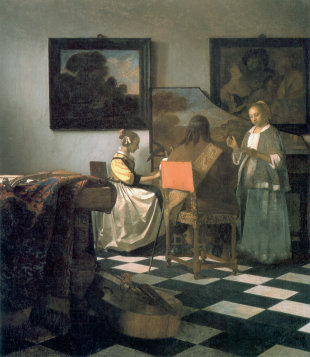Art theft - after the trade in drugs and arms - is the highest grossing criminal activity, according to the FBI.
The crimes that come to the public's attention are usually only the big cases, like the theft of Leonardo da Vinci's Mona Lisa in 1911 and Edvard Munch's The Scream, stolen in Oslo in 2004.
Both were recovered and it is thanks to the dogged determination of people like Christopher Marinello that such masterpieces are returned to their owners and galleries around the world. For he is an art detective.
His official title is executive director at the Art Loss Register, and in his role he has found more than ?160million of stolen artwork for individual collectors, museums and galleries around the world.
One of his recent successes was recovering a Matisse painting in Essex worth more than ?1million, 25 years after it was stolen from the Museum of Modern Art in Stockholm. Yahoo! News UK and Ireland interviewed Mr Marinello in his London office.Yahoo!:? What is the Art Loss Register?
Christopher Marinello: The Art Loss Register (ALR) was established in 1991, it has a database of 360,000 stolen art items. Rather than just maintaining a list of stolen items, we actively search the marketplace for whatever is on our list. I not only recover artwork; I mediate title disputes. For example, if one millionaire is buying a Degas from another millionaire and the Degas belongs to Holocaust victims, I facilitate the sale by working out a solution that satisfies the original owners.
Yahoo!: How often do you find database matches?
CM: Every week. Say if you're a collector who sees an antique clock on Portobello Road - you can contact us to make sure it's not stolen. I get calls all the time from people who claim to have leads on stolen work. Many aren't plausible like a recent call from someone saying that a well-known country singer has paintings from a famous Boston Museum heist.
Yahoo!: When you find a missing work, do you alert the police or meet with suspected art thieves yourself?
CM: I deal with criminals if I have the permission of the authorities. If artwork was stolen recently, the police are usually keen to get involved. If the theft happened 25 years ago, the police aren't as interested and in those cases I'm given permission to handle the case myself.
Yahoo!: Is that what happened with Le Jardin, the Matisse painting that you recently recovered in Essex and returned to the Museum of Modern Art in Stockholm?
CM: Yes - a private art dealer in Essex was approached by a guy in Poland to sell it in the UK so he contacted us to see if it was on the Art Loss Register. We saw it was stolen so we told the art dealer that we'd check the painting on delivery and to tell the Polish seller that he was going ahead with the sale. I also alerted Scotland Yard, just in case we needed to seize it at the border. Once it was back in the country, the art dealer was shown all the Interpol and police notices to prove it was stolen. We drafted a release which he signed and we got the painting back.
Yahoo!: So the case ends there - you don't try to find out who the thieves are?
CM: We told the police everything and if they want to investigate the Polish seller and solve the crime, they can do so. Or the Swedish police could try to solve the crime.
Yahoo!: But in 25 years, the painting probably changed hands so many times that it could be very difficult to trace the original thieves?
CM: You never know. In a case I'm working on now, I've met with a criminal who's been holding onto some very valuable artwork for over 30 years several times at a cafe in Paris. I want to resolve this thing because the family still wants their artwork back. We can prove who owns the artwork but we can't prove he's done the crime so it's a matter of trying to persuade him to give us the artwork.
Yahoo!: How closely do you work with Interpol and other art crime organisations?
CM: Very closely, although Interpol is not a force, it's an organisation that helps officers in one country deal with officers in other countries. On the other hand, the FBI art crime squad is an actual squad of 14 agents. The Italian Carabinieri are a serious art crime squad with 300 officers.
Yahoo!: Are there any new cases you can tell us about?
CM: We've got some really exciting unsolved cases on our books now including works by Modigliani, Braque, Leger, Matisse and Picasso from the Paris Museum of Modern Art theft in 2010 and work from the recent Kunsthal museum heist.
We are also working on getting back a Matisse for a family of Holocaust descendants in New York which is now in a museum in Norway. The documentation we have is signed by Hermann Goering ordering a gallery in Paris which had this Matisse to be closed in 1941. Goering then had the artwork seized and sent the family who owned the gallery to Auschwitz. Because Goering didn't like Matisse, he traded the piece to other dealers in Paris to get the Old Masters that he wanted. That's how it returned to the open market.
Yahoo!: What missing artwork would you really love to find?
CM: The ultimate recovery would be to find the work from the Isabella Stewart Gardner Museum heist in Boston. During the 1990 St Patrick's Parade where every police officer was at the parade, thieves dressed as police stole Vermeer's The Concert (at $200 million, the most valuable stolen artwork in the world), Rembrandt's Storm on the Sea, Manet's Chez Tortoni and 10 more pieces? artwork now valued at half a billion dollars. The museum is so keen to get the work back that they're offering a $5 million reward and anyone returning the work will not be prosecuted for the crime.
Yahoo!: Have the profiles of art thieves changed over the years? Are they getting more difficult to track? down?
CM: Thieves are always going to be thieves. Art thieves are common thugs. There's no romance there. The same people who'd steal your wallet would steal artwork. The internet has made it easier track but it's easier for the criminals as well. I can't go undercover anymore for instance because my picture is everywhere. The key is to get more people who buy and sell art to check the Art Loss database.
mega millions winning numbers autism speaks ubaldo jimenez ncaa final country music awards autism awareness angelman syndrome


No comments:
Post a Comment
Note: Only a member of this blog may post a comment.